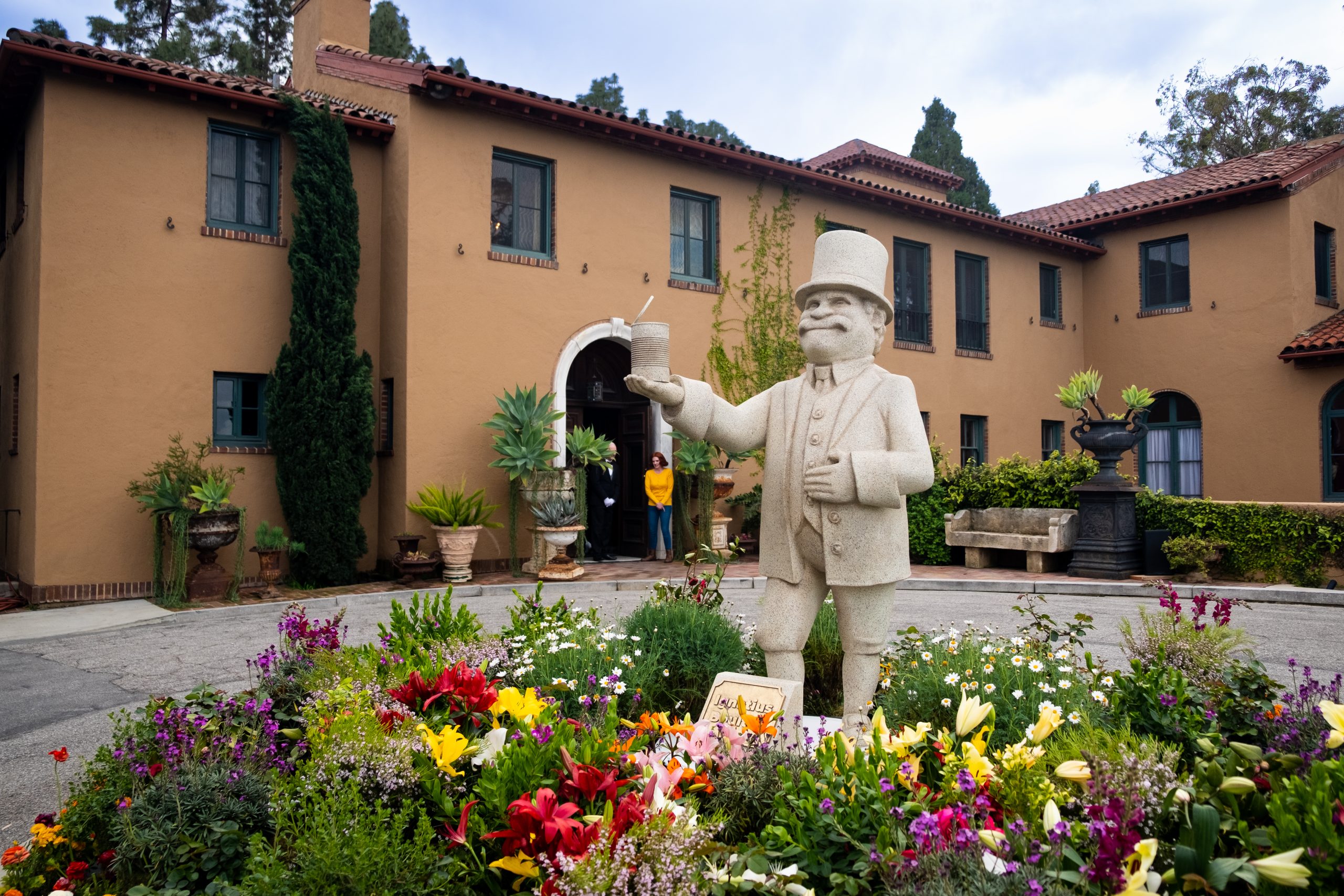How do you take the IP of a mobile game to build an entire narrative universe – and real-life experience – that pulls in both guests and fans worldwide?
In late 2022, experiential marketing agency Jack Morton Worldwide were tasked with building a magical, real-world experience that let fans into the cosy universe of the popular mobile game Merge Mansion. Bringing together experts in the fields of immersive theatre and world-building, they worked alongside the game’s developers to design a layered world of IP that earned the brand hundreds of millions of media impressions and a lot of fan love.
The gates to the real-world Merge Mansion swung open in Spring 2023, with a mysterious premise so intriguing that the world’s best “detectives” (a mix of fans and influencers, plus celebrity sleuth Pedro Pascal) had to find out for themselves once and for all what was going on inside its walls – and what Grandma was really hiding…
In this Case Study Campfire, Kali Heitholt, Senior Creative Director at Jack Morton Worldwide, and Jarrett Lantz and Jeff Leinenveber, Co-Creative Directors at Scout Expedition Co, take us on an exclusive journey into how they created not only a campaign and IRL experience, but an entire narrative universe. Expect to learn:
- The 5 steps to developing an “experience flow”
- How to use “anchor moments” and “actor moments” to move guests through an experience
- How to use generative AI to augment, not diminish, human creativity
Transforming A Mobile Game Into A Real-World Universe
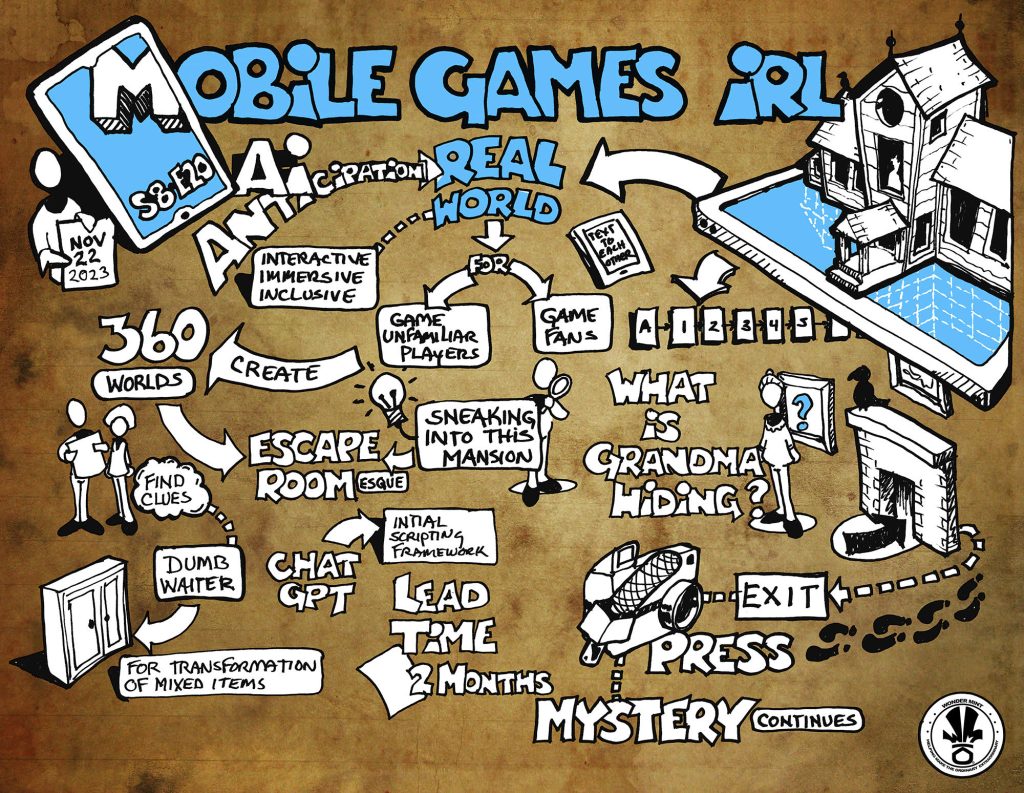
When Jack Morton were brought on board, Merge Mansion had already developed a rich lore, history and IP among fans. The storyline of “what’s Grandma hiding?” was already well established and they had already ventured into different kinds of storytelling with a Superbowl ad featuring Kathy Bates as Grandma.
The initial ask was for an Airbnb play, but Heitholt’s team felt that this wouldn’t cut it and that they needed to create a full mobile extension of the world so engaging that guests couldn’t resist exploring every nook, cranny, layer and texture. They took over an entire mansion in Silverlake, Los Angeles to recreate the actual Beaumont Hall featured in the game.
“There was so much within the space we called them ‘dinosaur Easter eggs’. It was incredibly layered.”
Kali Heitholt
The team developed three experience design principles to guide the strategy for the activation: interactive, immersive and inclusive. And while Heitholt acknowledges that these words are very overused in the experience space, here they were interrogated to mean something different at each moment.
- Interactive. Players would normally have a more passive experience, so this provided a unique opportunity to put them in the driving seat, give them a role, interact with characters and have a personal investment in the story. Key question: how might we create interactive moments to give them skin in the game?
- Immersive. The mysterious story behind Merge Mansion is the gravity that holds the universe together. It normally doesn’t give resolutions and has lots of dead ends, meaning there was a need to balance giving guests the autonomy to explore while also bringing them back for more. Key question: how might we bring people in by bringing the mystery and the details of this story to life?
- Inclusive. The experience needed to be designed to appeal to Merge Mansion superfans, total newbies and everything in between, and had to acknowledge all these different needs. Key question: how might we reward day ones and new players?
Rolling Out A Transmedia Campaign
The final result was what Heitholt calls a “genre-bending transmedia campaign” that not only happened in person, but also unfolded online so fans across the world could experience the magic.
“We believe in putting brand experience at the centre, with everything else trickling out from there. Modern audiences live a fluid lifestyle, particularly post-pandemic: they crave the connection from in-person experiences, but also need to be reached online and through social.”
Kali Heitholt
This campaign rolled out in three stages:
Phase 1: an online teaser trailer featuring celebrity detective Pedro Pascal, shared on social media and accompanied with mailer invitations to key influencers.
Phase 2: the opening event where celebrities, influencers, and fans arrived to investigate Beaumont Hall, accompanied by media interviews and Getty coverage to achieve the brand’s goals of making a media splash. This was also timed with the opening of the mansion in the mobile game.
Phase 3: a cinematic film created by the content capture team at the event and shared on social, so that people could feel part of it even if they weren’t there.
The entire process of pre through to post-production took several months:
- Late September 2022: development begins
- October – November 2022: presenting ideas to client
- Late November 2022 onwards: bringing in partner agencies in immersive theatre and worldbuilding
- January – March 2023: pre-production
- March 2023: 2-3 days load-in, 1 day playtesting, 1 day live event, 1 day content capture
The Experience: Moving Through Spaces & Narrative
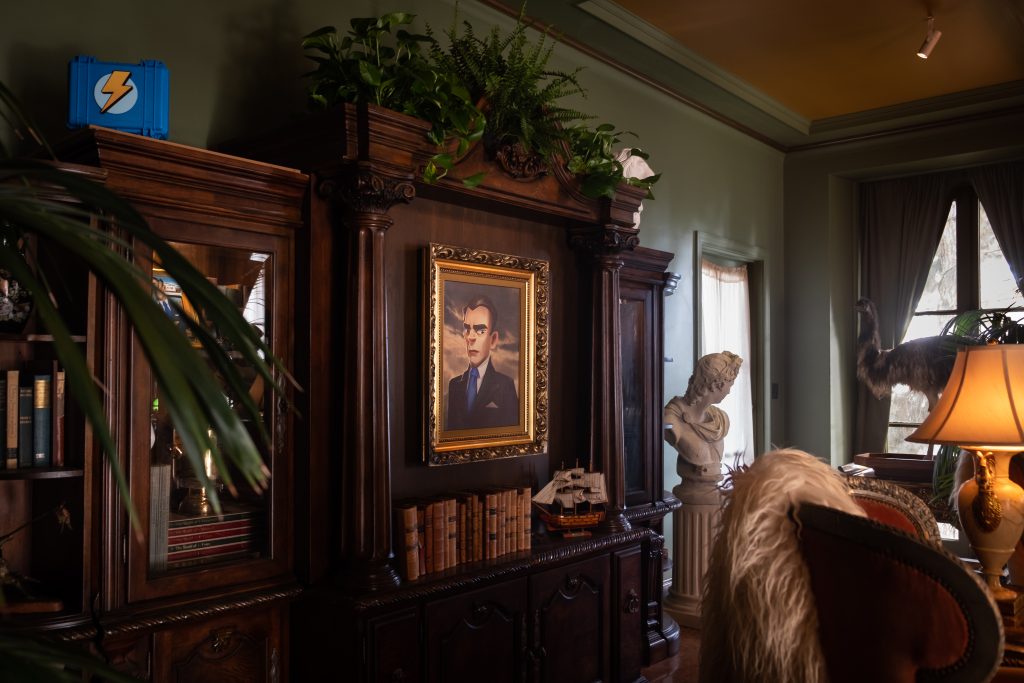
The experience itself took the form of a classic mystery adventure, allowing participants to live out their Cluedo/Knives Out fantasy. Specially selected superfans and influencers were invited to walk through Beaumont Mansion, gathering clues within each space and interacting with characters to unlock Grandma’s secrets.
“We call it part-live theatre, part-escape room on acid.”
Kali Heitholt
Jack Morton brought in immersive theatre experts Just Fix It to help with the storyline, and Scout Expedition Co for the scenic elements and gameplay. Together, they created a guest journey, experience flow and narrative universe along the design principles of interactive, immersive and inclusive storytelling.
- Create a linear guest journey and story arc
Several teams went through the mansion one at a time, meaning that the team had to think carefully about the guest flow. Having played with several journeys, they eventually settled on a linear journey through the different spaces within the experience.
“We found that the linear journey was the best way to bring groups in at different show times and waterfall them in to create intimate and personalised experiences. We set a cap on how many attendees came in and kept it small and personal.”
Kali Heitholt
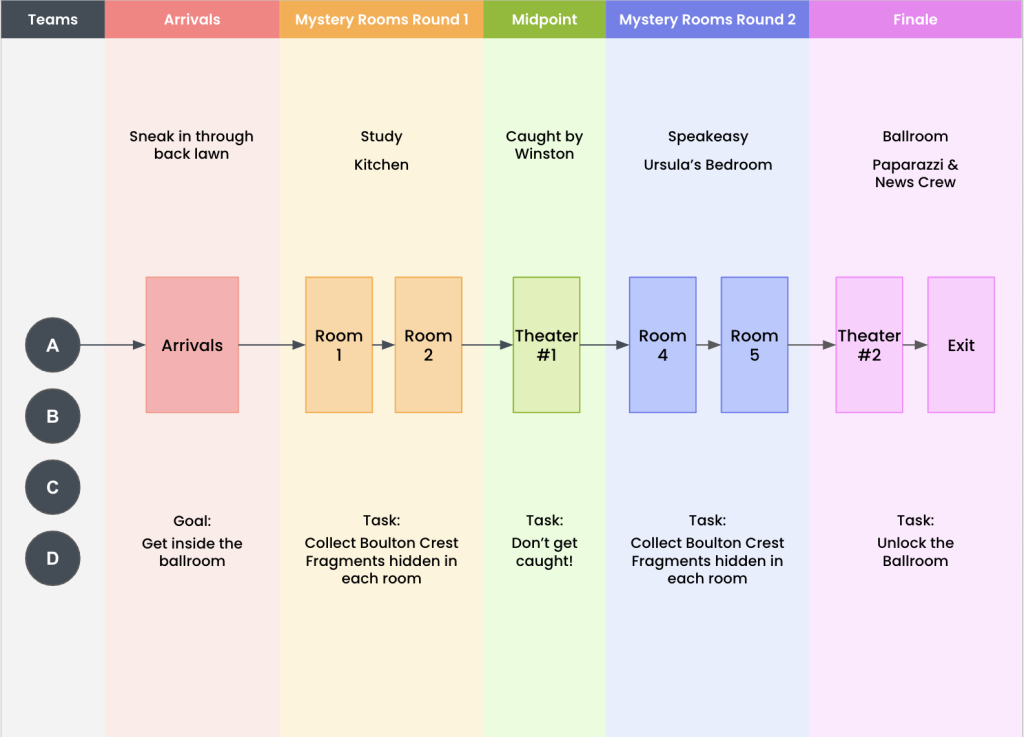
The next step was to craft a story arc. The team were given access to the story beats of the opening of the mansion within the mobile game, so they knew the locations that gamers were going to be able to play. They mapped these against a traditional storytelling arc with main tensions and climax, a mix of education and gameplay, and a resolution that allowed guests to storify and share their experience.
- Craft an experience flow with anchor moments
Scout Expedition Co were brought in to work on the “experience flow” and how guests were driven from one room to the next. They defined several “active spaces” that were distinct from each other in terms of visuals, time periods, characters and gameplay, as well as “passive spaces” when travelling in between where guests would encounter live moments of theatre and interact with characters like the gardener, butler or maid. These active spaces were:
Scout then worked on sketches of the floor plans for each space to develop a general flow, followed by an experience flow that gets everyone on the same page with how people will interact with and progress through the space. These experience flows highlight anchor moments within each scene – for example, in the Study completing a puzzle unlocks a cinematic moment where money flies out of the fireplace – as well as actor interactions and interventions like text messages.
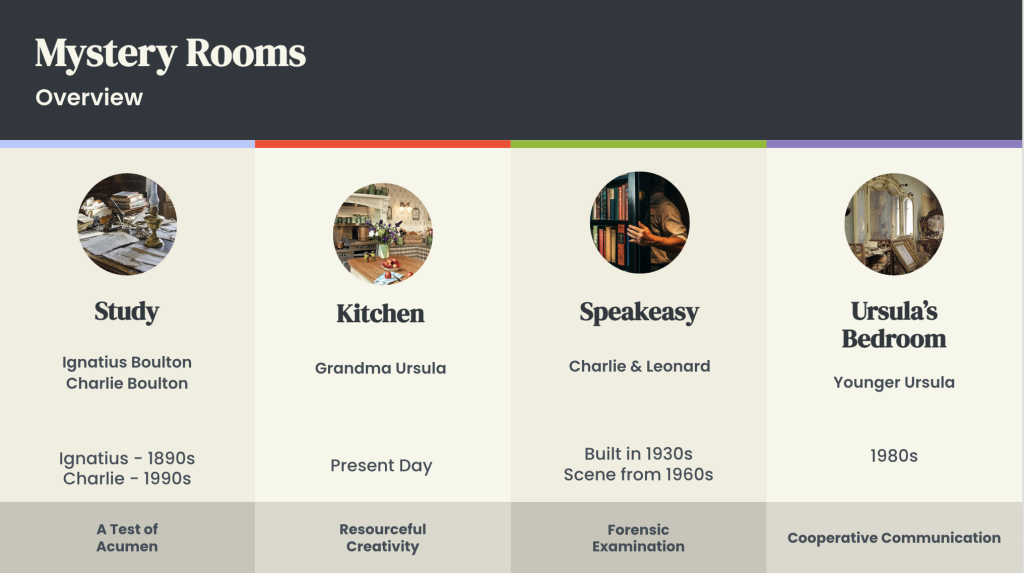
“It’s about getting in the point of view of the audience: where they’ll go first, what they’ll do, and how they’ll engage.”
Kali Heitholt
- Create 360-degree worlds in each space
One of the biggest creative challenges of the project was to take a tiny cut scene from a mobile game and turn it into a 360-degree concept with the depth of a feature film, where everything in the space became something the audience could interact with and learn from.
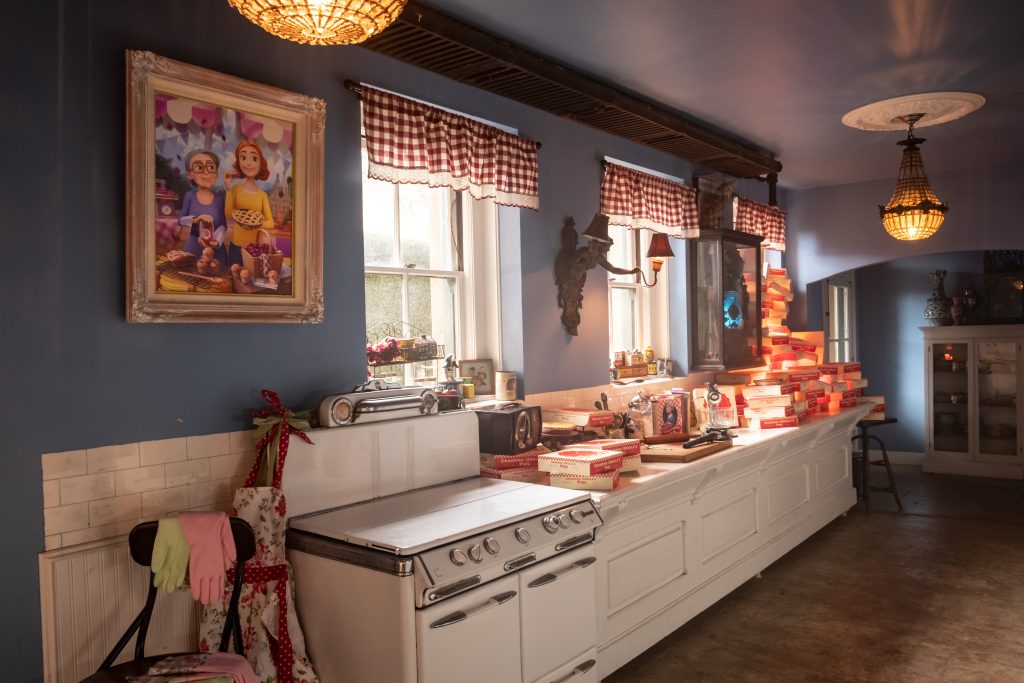
Working in a historic mansion also provided its own design challenges of both utilising an existing space and transforming it into something new, and creating a low-impact design that could be reset without leaving a trace. In some spaces, this meant just adding a layer of set dressing, and in others it meant building sensitively around the space – for example, in Grandma’s bedroom a fake wall was built in that revealed a secret entrance in the fireplace. In others, the building provided inspiration for the story design – a dumb waiter in the kitchen turned out not to work, but inspired the team to build their own to reflect the in-game mechanic of merging two items.
While the game also had some well-established IP, when it came to the fictional family tree the team only had breadcrumbs from the developers, so had to craft their own IP alongside them to figure out what they could include in the new storyline. Once this was agreed, they then had the challenge of creating enough touchpoints to bring this fictional universe to life.
The team leaned into new technologies, particularly generative AI, to avoid burnout among the creators and enable them to focus on the key, anchor moments that would have the most impact. Their graphic designer created custom graphics to flesh out the world, and then used Midjourney and ChatGPT to supplement, not replace, this human creativity to build in more layers of detail than would usually be possible.
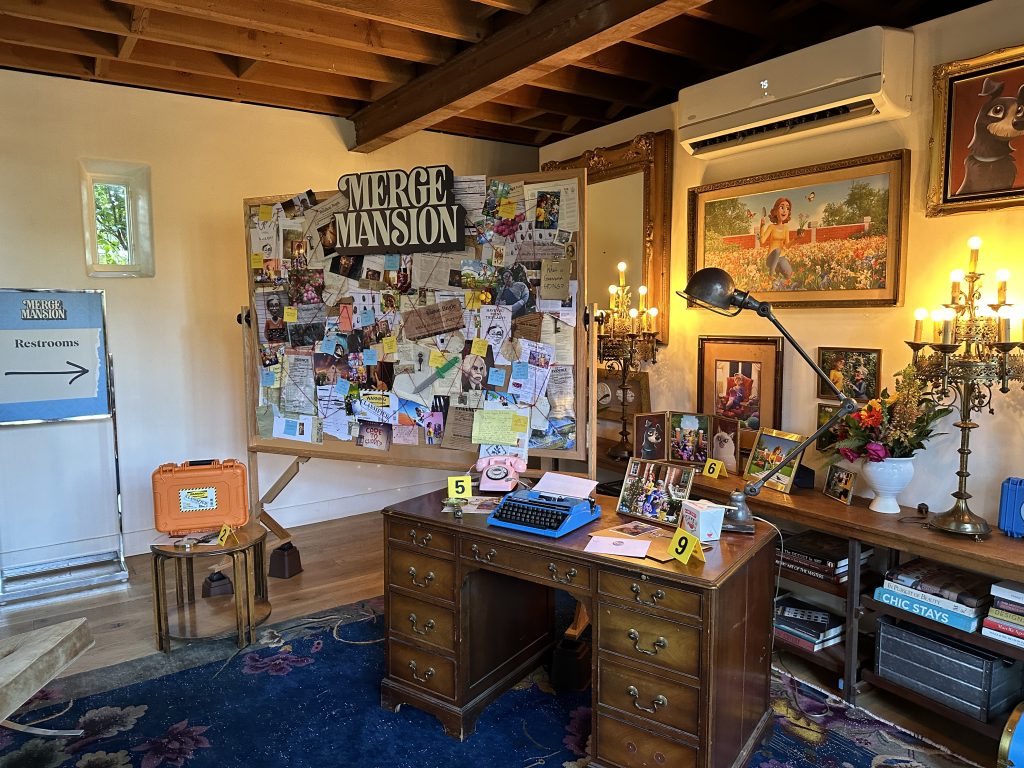
“It was still a bit of a Wild West when it came to responsibly using these tools in a unique and creative way, so it involved a lot of experimentation. With AI, we were able to generate quick images and then work in our own detail, or generate copy for the backs of books to replace Lorem Ipsum text that might have ruined the illusion of this fictional world. It allowed us to invest our time in big, cinematic moments without getting bogged down in small details.”
Jeff Leinenveber
AI was also used to achieve the right tone of voice in the promotional trailer and to manipulate voicemails on burner phones used in the game.
- Use actors as a story engine
Just like game-masters are key to helping people progress through a traditional escape room, at Merge Mansion actors were pivotal to keeping the narrative flow seamless and making sure people were where they needed to be. Just Fix It cast people specialising in improv theatre, who could both interact with the guests spontaneously but also make sure that the storyline was on track and to give them permission to interact with the set and puzzles where needed. (This reminds us of the use of actors in David Byrne’s Theater of the Mind, where improv actors interacted with guests but also mechanically moved them through the space based on set cues and timelines.)
“The actors were allowed to have autonomy, but they were also there as a fallback to push people forward and make sure they progressed. They were the engine that kept the show moving forward.”
Jeff Leinenveber
The live characters were also integrated through the mechanism of a burner phone given to guests, where they would text, call and FaceTime participants both to break up the experience and to help them crack clues and move forward. As the original game is mobile-based, this also provided a connection to its roots. (A similar approach was used in Swamp Motel’s The Drop, where guests were invited to text and call mystery numbers throughout the experience to unlock further pieces of the narrative.)
- Create a transition back to reality
In each space participants would receive a piece of the family crest when they solved the clues or challenges, allowing them to access the final locked room: the Ballroom. This gave an opportunity for a final moment of immersive theatre, when guests discover Grandma has been ahead of them all along. Just like the game itself, for the questions you get answered, more questions are posed.
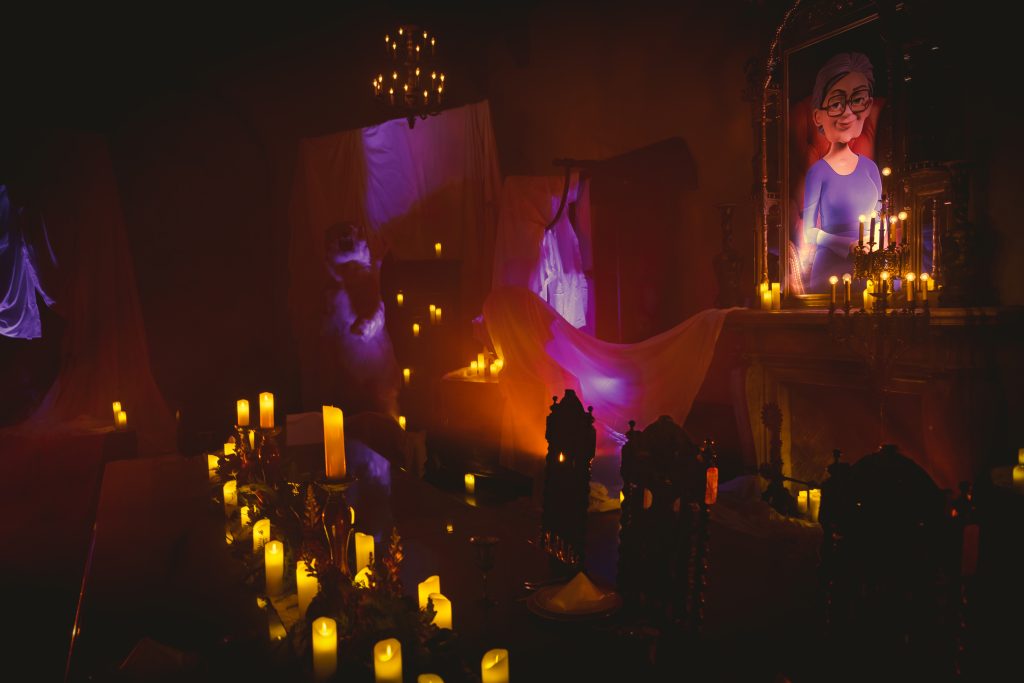
The team wanted to find a more immersive way to transition people out of the experience rather than simply showing them the exit. A silhouette of Grandma running across a balcony, and prompted by some encouragement from the actors, saw the guests follow her outside, where they’re immediately greeted by “press” asking them about their experience inside.
This ending served a few purposes:
- The team wanted to hear people’s theories about the mystery. The press provided an opportunity for instant conversation, and was more organic than a sit-down interview.
- By asking them for their experience immediately, the team gave participants an in-the-moment chance to “storify” and integrate what had happened to them.
- Just as gradually crossing the threshold is important to bring people into the story of your experience, guiding them back to the real world requires consideration.
“You’re so immersed in the world we’ve created that just like diving, we want it to be a seamless transition back to reality.”
Jeff Leinenveber
The WXO Take-Out

The experience Jack Morton and its collaborators created for Merge Mansion is very specific to the game world it reflects – but it also contains highly transferable tips for world-building in a variety of experiences.
We love the idea of crafting an experience flow from the point of view of the participant, mapping it against the physical locations and story arc to pinpoint anchor moments, moments of transition, and goals that need to be achieved to trigger the next part of the story.
And the use of new tools such as generative AI to create new depths of detail demonstrates that while we’re still working out the ethics of how to apply them, there’s still massive potential for them to augment, rather than diminish, human creativity.
So next time you’re creating an experience, ask yourself:
- How can you engage audiences pre, during, and post to create a campaign with a traditional storytelling arc?
- How can you use AI to explore the ideation process?
- What additional elements could you include to create a rich world for attendees to uncover?
Want to come to live Campfires and join fellow expert experience creators from 39+ different countries as we lead the Experience Revolution forward? Find out more here.

